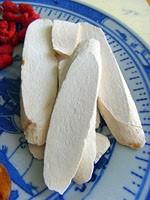Rhizoma Dioscoreae
- Name
- Origin
- Where Does It Grow?
- Nature and Flavor
- Identified Active Components / Major Chemical Constituents
- Drug Actions in TCM
- Traditional Uses in TCM
- Pharmacological Actions
- Toxicology
- Administration and Dosage
- Adverse Effect, Side Effects and Cautions
- References
Name
Latin Name: Rhizoma Dioscoreae
Common Name: Chinese yam
Scientific Name: Dioscorea opposita Thunb.
Chinese Name: 山藥
Pinyin Name: shan yao
Origin
The root of Dioscorea opposita Thunb., a perennial trailing plant of the Dioscoreaceae family. The medicinal part is used in raw form or processed by stir-frying with bran.1,2
Where Does It Grow?
Chinese yam is mainly produced in Henan province; other regions like Hunan, Jiangxi, Guangdong and Guangxi provinces are also produced. All of them provide cultivated herbs.1
Nature and Flavor
Chinese yam is neutral in nature, sweet in flavor, and mainly manifests its therapeutic actions in the spleen, lung and kidney meridians.2
Identified Active Components / Major Chemical Constituents

Drug Actions in TCM
Chinese yam can replenish qi (vital energy), enrich yin, reinforce spleen, lung and kidney, and arrest excessive essence depletion.2Traditional Uses in TCM
Pharmacological Actions
Toxicology
None.4
Administration and Dosage
Orally, the usual dose is 15~30g, it can be up to 60~250g if necessary. Chinese yam in raw form is suggested for nourishing yin, when stir-fried with bran, it can invigorate spleen and arrest diarrhea.2
Adverse Effect, Side Effects and Cautions
References
- Li Jiashi (editor-in-chief), Chinese Medicine Identification, Shanghai Scientific and Technical Publishers, 2000-2.
- Lui Daiquan (editor-in-chief), Chinese Herbal Medicine, Shanghai Scientific and Technical Publishers, 2000-6.
- Tao Yufeng, Clinical Herbal Medicine, People¡¦s Medical Publishing House, 2005-5.
- Chen Pian, Clinical Application of Tonifying Herbs, Second Military Medical University Press, 2008..
- http://www.tcmlib.com/zy/html23/showdetail-323237322ce5b1b1e88daf2c7a79.html


